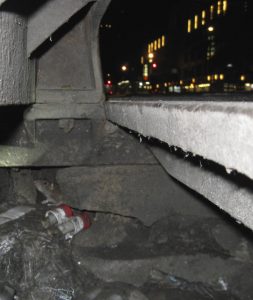
Consider the rat — the urban sort. Then consider our health, our food, and the damage rats do to our buildings. Yet despite the considerable impact they have, there’s not much science out there. Until recently, most of the research dates back to the mid-1900’s.
Now, though, rodent researchers worldwide are taking a closer look at rats — at their biology, ecology and evolution. Here are some takeaways:
Genomics shift as cities change.
Consider the evolution of life in large cities — and how understanding these changes can help us cope with rats. For instance, an eight-lane highway or even a really busy street are as dangerous for rats to cross as they are for us. Unlike us, however, rats have few opportunities to date (and hence to mate with) other rats from across, say, Broadway. (A side street poses less of a problem). As we learn what gene flow teaches us, we can see that the areas rats occupy — whether a single building or several city blocks — matters. A lot.
After all, ridding rats from a bagel shop or coffee bar doesn’t really help if rats can quickly re-infest the premises from establishments down the street.
Metro New York’s rats arrived in the 1700’s — then closed the doors.
The Big Apple’s rats are evolutionary kin of — believe it — rats from Great Britain and France. Sure, the colonies traded mainly with Britain and France during the 1700’s. But what’s surprising is the lack of evidence for rat introductions from any other part of the globe. This suggests that the rats that took up shop in what was then a small but fast-growing burg killed or repelled every rat that arrived at the Port of New York since then. Ecologists call this biotic resistance.

Rat populations are patchy in urban areas.
Several studies showed that rats mainly occupy urban hot spots where food, water and shelter abound. Might rat genomics lead to habitat preferences? Do some prefer to live in high rises, others in parks and still others in warehouses or office buildings — all in the same cluster of blocks? Indeed, rat colonies nearby could differ genetically while those further away but in similar habitats show similarities.
Regardless — just short of a mile is what it takes to separate one colony from another. The occasional rat that crosses that boundary isn’t enough to keep them genetically related. Your Uptown Rat and your Downtown Rat — forget any romance there.

Rodent-borne disease is patchy in urban areas.
Just as rat populations are patchy in urban environments, rodent-borne disease is also found in hot spots. Consider Bartonella. This group of bacterial pathogens has a number of health consequences for people, but the recent research shows that
- some populations had high percentages of infected rats
- rats from those sites were host to a greater diversity of pathogens and ectoparasites
- human health risks are unknown and can be known only with more complete sampling

In urban areas, rats are really hard to study.
As people who have conducted rodent research, we can tell you that rats are hard to study. They’re secretive, they nest underground, they’re nocturnal, accessing them is difficult — and they’re likely to croak before we can study them. Radio telemetry and Global Positioning System (GPS) rarely work because of interference from buildings and hard surfaces.
Urban rodents have plagued cities around the world throughout recorded history. But with the tools of modern science we can glimpse their complex and secretive lives, exposing some of their mysteries. With more questions than answers, the field of urban rodentology is an open book.
Recent Rodent Research Articles (November 2017)
Angley, LP, MC Combs, C Firth, MJ Frye, I Lipkin, JL Richardson, & J Munshi-South. Spatial variation in the parasite communities and genomic structure of urban rat vectors in New York City. Zoonoses and Public Health DOI: 10.1111/zph.12418
Byers, KA, MJ Lee, CM Donovan, DM Patrick, & CG Himsworth. 2017. A Novel Method for Affixing Global Positioning System (GPS) Tags to Urban Norway Rats(Rattus norvegicus): Feasibility, Health Impacts and Potential for Tracking Movement. Journal of Urban Econology 3(1): jux010
Combs, M, EE Puckett, J Richardson, D Mims, & J Munshi-South. 2017. Spatial Population Genomics of the Brown Rat (Rattus norvegicus) in New York City. Molecular Ecology
MTJ Johnson & J Munshi-South. 2017. Evolution of Life in Urban Environments. Science 358(6363): eaam8327
Peterson, AC, BM Ghersi, F Alda, C Firth, MJ Frye, Y Bai, LM Osikowicz, C Riegel, WI Lipkin, MY Kosoy, & MJ Blum. Rodent-borne Bartonella infection varies according to host species within and among cities. EcoHealth. https://doi.org/10.1007/s10393-017-1291-4